
Contents
RRH Index
Extreme Dilute
Syrian Hamsters
Description
History
Genetics
Breeding
Experimental Proofs of
Gene Character and
Transmission
Albinism
ED Photo Gallery
Recessive Dappled
Syrian Hamsters
Description
History
Genetics
Breeding
Experimental Proofs of
Gene Character and
Transmission
Comparison to Other
Patterns
Testing for Allelism with
Dominant Spot
RD Photo Gallery
Working on Type
Syrian Hamster
Genetics
Contact
|
Albinism An albino is an organism exhibiting deficient or absent pigmentation in the skin, hair and eyes. The classical abino has no melanin pigment at all, resulting in white hair, white/pink skin and pink or light blue/grey eyes. There are also many forms of incomplete albinism where pigment is present in reduced amounts or is only produced under certain conditions. Since melanin is required for proper development of the eye, albinos often have moderate to severe vision problems. There is a gene present in most animals that codes for an enzyme called tyrosinase. The job of tyrosinase is to start the transformation of the amino acid tyrosine on its way to becoming melanin pigment. After many steps, tyrosine ends up either as brown-black eumelanin or as yellow-red pheomelanin. Many other genes can affect this pigment-making process at any number of points — interrupting its completion, changing the relative amounts of the two pigments, allowing only one kind of pigment — but without tyrosinase, these are irrelevant. In genetics laboratories, the tyrosinase locus is symbolized tyr. Outside of labs, we usually call it C for "color." Since every individual has two genes for each locus, most often there are two copies of C. The animal's genotype is CC and it has "full color", exhibiting whatever color is mandated by the rest of the genes that affect pigment and its distribution.
To the right are two Golden Syrians both with only one normal tyrosinase gene. Top: shorthair female. Bottom: longhair male. Here the longhair itself dilutes the color, but this is unrelated to albinism. *This is not universally true. See Cremello. Also, it is known that mice of certain colors are slightly lighter if they have only one full-functioning C gene. A mutation in C resulting in useless or completely absent tyrosinase is called c. In a Cc animal, one gene is cranking out all the tyrosinase needed to make pigment while its partner on the sister chromosome contributes nothing. This becomes significant only when two Cc animals mate. Then there is a 25% chance that any progeny will be cc. Since tyrosinase is the first gate to melanin pigment production, none is produced anywhere. Hair is white. Skin and eyes are pink since there is no melanin to cover the red heme in blood. These are the classical albinos. Classical albinism is present in many, if not most, mammalian species. In humans, about 1 in 70 people carry the gene, leading to an incidence of albinism of roughly 1 in 18,000. In Syrian hamsters, however, the mutation has not been recognized, if it has occurred.
When the tyrosinase gene is less than totally disabled, varying amounts of pigment can be present. The intensity of color and its distribution depend on the specific mutation. In mice there are well over a dozen known C locus mutations that are not c types. Some have arisen spontaneously in laboratory strains; others have been induced by irradiation or chemical mutatgens. Three are in the mouse fancy gene pool. These are called chinchilla, extreme dilution and himalayan (siamese). Up until recently, only one partial albino gene, Dark Eared White, was known in Syrian hamsters. Now, extreme dilution has also been identified.
A cdcd hamster has a snow white coat, red eyes and dark grey ears. The ear color is absent at birth, developing at about 30 days of age.
Although no other C locus alleles are known in Syrian hamsters, there are several others that are commonly found in mammalian species. Each variation has similarities across species lines, but there is not great consistency in names or symbol assignment. A few of the most common are described here.
Chinchillated animals have a slight reduction in black pigment and greatly diminished yellow pigment. This generally results in a grey coat that lacks the golden or brown tones of the wild type. Confusing the issue is the use of the term to describe fur that has this look but is from different causes.
Both these terms refer to tyrosinase mutations that are heat labile. At body temperature, the enzyme is disabled so that very little pigment is formed in central body locations. At the periphery, where the tissues are cooler, pigment can be produced in nearly normal amounts. These areas are called the "points" and include ears, nose, feet, tail base and scrotum. Animals kept in cold environments will have more color. This happens also in the wild during the winter season. Most homozygotes have white or light tan fur with brown or black points. In felines and mice this gene produces almost complete albinism. The animals have a translucent white coat and washed-out, pale blue eyes. The equine palomino gene is also called cream or cremello. It is unusual in that it is codominant to C. Horses with one ccr are palomino. With two, they are cremello — very pale cream, almost white, with white mane and tail and blue eyes.
Any individual can have any two-allele combination of these C locus genes, depending on what is in its species gene pool. Leaving aside C, the combinations are usually intermediate in appearance between the homozygous forms. In the case of himalayan, the combination form has points. Some of the albino family genes completely mask other colors. No matter what the rest of the genotype codes for, the fur of a classical albino will always be pure white. This is also true of a Dark Eared White Syrian hamster. However, the forms of partial albino that allow some fur pigmentation can interact with the underlying color to form shades that differ. The above descriptions refer to animals that are wild type except at the C locus. |

No part of this website may be reproduced in any form or by any means
without the prior written consent of the owner.
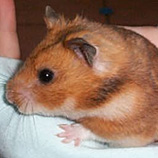 If an animal has inherited a defective C gene that functions inadequately or not at all, then it
only has one normal copy of the gene. As it happens, one copy is sufficient to generate enough tyrosinase to make all the necessary pigment, so an animal with one normal C and one
abnormal C is indistinguishable in appearance from one with CC.* In this case, we say that C is completely dominant over the defective gene. Conversely, the defective
gene is recessive to the normal one.
If an animal has inherited a defective C gene that functions inadequately or not at all, then it
only has one normal copy of the gene. As it happens, one copy is sufficient to generate enough tyrosinase to make all the necessary pigment, so an animal with one normal C and one
abnormal C is indistinguishable in appearance from one with CC.* In this case, we say that C is completely dominant over the defective gene. Conversely, the defective
gene is recessive to the normal one.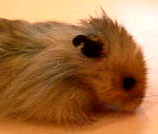
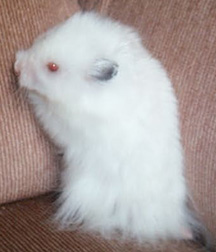 The C locus gene called Dark Eared White was discovered in the U.S. in 1952. It produces a
partial albino phenotype when homozygous. It is sometimes referred to as acromelanic albino, meaning "color at the tips", but this term is also used for the temperature-sensitive tyrosinase
genes, usually called himalayan or siamese. Ear color in Dark Eared White hamsters is not dependent on temperature.
The C locus gene called Dark Eared White was discovered in the U.S. in 1952. It produces a
partial albino phenotype when homozygous. It is sometimes referred to as acromelanic albino, meaning "color at the tips", but this term is also used for the temperature-sensitive tyrosinase
genes, usually called himalayan or siamese. Ear color in Dark Eared White hamsters is not dependent on temperature.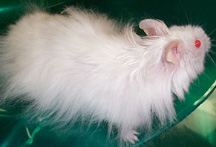 When hamster aficionados say that there is no Syrian albino, they mean that there is no classical
albinism in the species. There is a phenotype though that fools people into thinking it's albino since there is no visible pigmentation. It is Flesh Eared White which is a combination of
Dark Eared White and Cinnamon. Cinnamon prevents pigment formation in the ears; Dark Eared White prevents it everywhere else.
When hamster aficionados say that there is no Syrian albino, they mean that there is no classical
albinism in the species. There is a phenotype though that fools people into thinking it's albino since there is no visible pigmentation. It is Flesh Eared White which is a combination of
Dark Eared White and Cinnamon. Cinnamon prevents pigment formation in the ears; Dark Eared White prevents it everywhere else.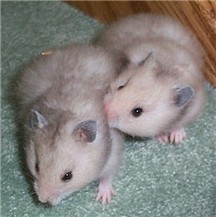 Mice homozygous for extreme dilution have very light grey hair and black eyes. The mutation was
found in the wild. Eumelanin is strongly reduced, and pheomelanin is nearly absent. In Syrian hamsters the mutation is believed to have originated in a commercial hamstery along the U.S.
east coast in 1999. Homozygotes have a light grey agouti coat with black ticking, dark grey ears and black eyes with a red glow. For more information see
Mice homozygous for extreme dilution have very light grey hair and black eyes. The mutation was
found in the wild. Eumelanin is strongly reduced, and pheomelanin is nearly absent. In Syrian hamsters the mutation is believed to have originated in a commercial hamstery along the U.S.
east coast in 1999. Homozygotes have a light grey agouti coat with black ticking, dark grey ears and black eyes with a red glow. For more information see